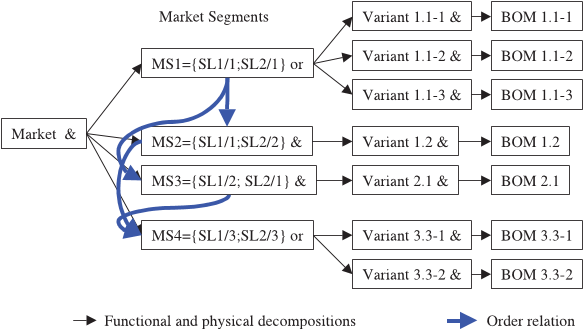Q2. What is the purpose of the bill-of-materials?
During a planning process, the bill-of-materials is used in order to compute net requirement of items given the demand of final products.
Q3. How many synchronous facilities do you have?
The supply chain gathers: 4 synchronous facilities, each one dedicated to a customer, 7 manufacturing facilities with 3 dedicated to computers and 4 to components.
Q4. What is the flow of the item?
The flows under question will be the item internal production flow, the item supplying flow from other facilities, and the item delivering flow to customers.
Q5. What is the purpose of the proposed model?
Another interest of the proposed model is to investigate the influence of the fixed cost of existence of variants on the diversity level of the product family.
Q6. What are the main strategies used to design the architecture of a product family?
In order to design the architecture of a product family two main strategies are identified which the authors call ‘‘market-segment oriented’’ strategy and ‘‘modular’’ strategy.
Q7. What is the purpose of the definition of a product family?
From the product point of view, a product family is a set of physical product variants and is defined in order to fulfill the market needs.
Q8. What is the key idea of a bill-of-materials?
To match the extension of a classical bill-of-materials, the key idea is to add new notions of ‘‘logical item’’ versus ‘‘physical item’’ and ‘‘exclusive OR’’ node versus usual ‘‘AND’’ node.•
Q9. What is the result of the bill-of-materials design process?
The result of the bill-of-materials design process appears to be a tree decomposition of the market needs (throughout the unbold arrows).
Q10. What is the definition of a mixed integer linear programming model?
A mixed integer linear programming model is defined in the following as an extension of basic models such as: (i) a single shipping channel is available between any two facilities; (ii) manufacturing or shipping activities have much smaller lead-times than the time period, and thus are supposed continuous.
Q11. How many experiments have been made to solve the problem once?
In order to do so, a set of experiments has been made in which the variant existence costs are multiplied by a coefficient between 0.01 and 150.
Q12. What are the main interests of the authors in the design of a product family?
These works underlined various interests in adapting the design of a product family in order to enhance the costs and lead-time of a given supply chain.
Q13. How long does the combinatory take to complete?
Computation time decreases with the combinatory, as shown in Fig. 12, until the duration reaches 115 seconds when combinatory equals 1.
Q14. What are the common extensions in global supply chain models?
Many extensions have been introduced in global supply chain models such as financial cost (duties, taxes, exchange rates) or scale economies or choices of technological manufacturing systems or demand instability.
Q15. What is the difference between the two product families?
As the authors consider an order relation between the service levels of each requirement, a partial order relation also exists between the product variants within a product family: a Variant V1 is greater than a Variant V2, if, for each requirement, the service level of V1 is greater than the service level of V2.












